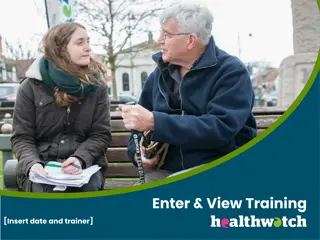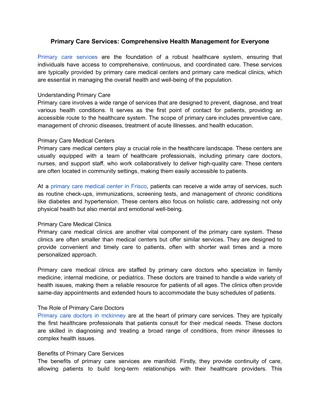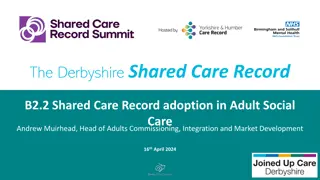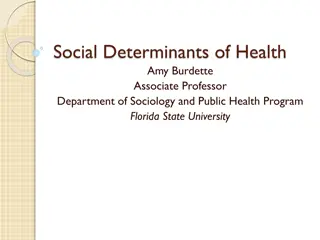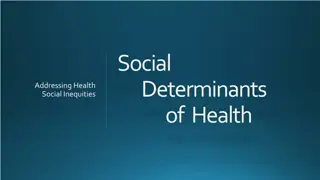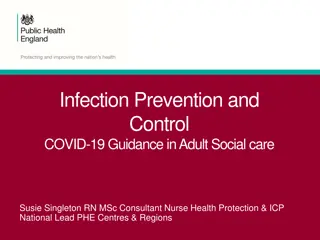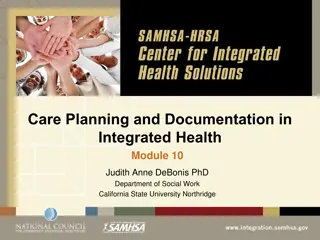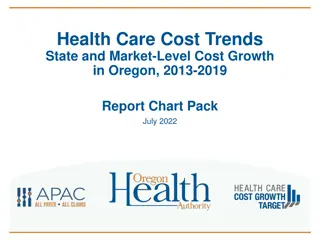Understanding Enter and View in Health and Social Care
Introducing the concept of Enter and View in health and social care, this article discusses the powers of entry held by various organizations, the legislative framework governing Enter and View activities, and the purposes for which local Healthwatch organizations can access premises and observe services. It delves into the importance of collecting feedback, reporting findings to relevant stakeholders, and informing decision-making at both local and national levels.
Download Presentation

Please find below an Image/Link to download the presentation.
The content on the website is provided AS IS for your information and personal use only. It may not be sold, licensed, or shared on other websites without obtaining consent from the author. Download presentation by click this link. If you encounter any issues during the download, it is possible that the publisher has removed the file from their server.
E N D
Presentation Transcript
An Introduction to Enter and View
Health and Care Powers of Entry There are a number of organisations that have Powers of Entry as well as local Healthwatch, including the Care Quality Commission (CQC) and the Human Tissue Authority. These powers have been carefully considered by the Department of Health who has ensured, through a process of challenge, that there is a clear and compelling case for these powers that protect health and care products and services There are also organisations that do not have Powers of Entry, such as local voluntary sector organisations.
The legislation applied to Enter and View Two pieces of legislation sit behind Enter and View which place a duty on service providers to allow a representative of local Healthwatch organisations to enter certain premises and observe certain activities; the Local Government and Public Involvement in Health Act 2007 (as amended by the Health and Social Care act 2012) and National Health Service Act 2006/ Local Government and Public Involvement in Health Act 2007 (as amended by the Local Authorities (Public Health Functions and Entry to Premises by Local Healthwatch Representatives) Regulations 2013. In addition, the Department of Health Review of Health and Care Powers of Entry 2014 further explains that the regulations place a duty on services providers to allow a representative of local Healthwatch organisations to enter certain premises and observe certain activities. There are criteria that local Healthwatch organisations must meet in order to exercise the power of entry, which include the consent of the provider.
What is Enter and View? Local Healthwatch have powers of entry, and providers have a duty to allow entry, if local Healthwatch operate under the principles of the legislation set out below: To go into health and social care premises to hear and see how people experience the service To collect the views of people at the point of service delivery To collect the views of carers and relatives of service users To observe the nature and quality of services To collate evidence-based feedback To report to providers, regulators, Local Authority and NHS commissioners and quality assurers, the public, Healthwatch England and any other relevant partners To develop insights and recommendations across multiple visits to inform strategic decision making at local and national levels.
Where does Enter and View apply? The guiding principle: the legislation allows Enter and View activity to be undertaken on premises where health and social care is publically funded: NHS Trusts NHS Foundation Trusts Local Authorities Primary medical services, such as GPs Primary dental services, such as dentists Primary Ophthalmic services, such as opticians Pharmaceutical services such as community pharmacists Premises which have been contracted by Local Authorities or the NHS to provide health or care services, such as adult social care homes and day- care centres.
Where does Enter and View not apply? The duty to allow entry does not apply in the following circumstances: If the visit compromises either the effective provision of a service or the privacy or dignity of any person Where the part(s) of premises are used solely as accommodation for employees Where health and social care services are not provided at the premises (such as offices) or where they are not being provided at the time of the visit (for example when facilities and premises are closed) If, in the opinion of the provider of the service being visited, the authorised representative, in seeking to Enter and View its premises, is not acting reasonably and proportionately If the authorised representative does not provide evidence that he or she is authorised
Where does Enter and View not apply? The duty to allow entry does not apply in the following circumstances: If the premises where the care is being provided is a person s own home, e.g. privately funded assisted living facilities. This does not mean that an Authorised Representative cannot enter when invited by residents it just means that there is no duty to allow local Healthwatch to enter. Where the premises are non-communal parts of care homes, e.g. a resident s bedroom. If a resident asks an authorised representative to come into their bedroom, the local Healthwatch decides to agree to this, they need to feel comfortable they are operating within their own safeguarding policies and procedures, and the situation has been risk assessed. If there are no people receiving publically funded services being provided on the premises. The duty does not apply to the observing of any activities which relate to the provision of social care services to children. If you are unclear about how a service is being funded, speak to the commissioner of the service.
PRACTICAL ACTIVITY What are the benefits? What are the risks?
Risks of Enter and View The learning from the network over the last few years has identified the following areas of risk which can impact both on the reputation of local Healthwatch, but also on service users and service providers Lack of understanding of Enter and View, and it being used in a situation where there are a number of other organisations already involved Unannounced Enter and View visit occurring on the same day as CQC inspection or similar activity (where this was not planned). Authorised Representatives not being clear about the role of Enter and View and not able to explain to service users the purpose of the visit, not having enough training to meet the communication needs of the service user, or not being able to manage any personal agenda they may have towards a service. Enter and View reports being written from one person s perspective, and not being grounded in what service users have told local Healthwatch Recommendations being unclear as to what they are asking, who they are aimed at and are unachievable.
Local Healthwatch and CQC working together The views and experiences of local people are good sources of information that can help support the oversight of change in local services and monitoring of agreed improvements by providers. Local Healthwatch are the eyes and ears of the community and can help CQC better understand how change and service improvement is taking place and how it is affecting people. Local people understand how local care systems really work and can often offer advice about solutions to entrenched local system problems. Local Healthwatch and CQC teams can: Proactively engage local people and communities around the impact of possible service changes as a result of inspection activity avoid surprises so that support can be provided for people affected by changes. Make good use of examples of good practice in service provision consider how to jointly promote and support its spread and adoption across a wider area. CQC teams can also seek advice and support from local Healthwatch about how to reach and how to engage specific groups and communities, especially at times when enforcement action is being taken.
In summary Local Healthwatch organisations use their powers of entry to gather the views of health and social care service users, families and carers , to improve the quality of health and care services. The regulations place a duty on service providers to allow a representative of local Healthwatch organisations to enter certain premises and observe certain activities. There are criteria that local Healthwatch organisations must meet in order to exercise the power of entry, which include the consent of the provider. There are benefits to Enter and View, but there are also risks.
Why, Where, What, How and Whom ENTER AND VIEW: PURPOSE
Purpose The purpose of Enter and View can be part of our prioritised plan of work or responsive to local intelligence. Broadly, the purpose will fit into 3 areas of activity: 1. To contribute to a wider local Healthwatch programme of work 2. To look at a single issue across a number of premises 3. To respond to local intelligence at a single premises It is also a requirement for our local Healthwatch annual report that we report on the following: The reason we decided to undertake any Enter & View activity. Any further action we took as a result of undertaking Enter & View activity (e.g. making recommendations, identifying good practice, notifying regulators).
Why is a clear purpose important? Why is purpose important? A clear purpose for a visit leads to clear decisions about who should visit, when, using what process Providers will be more accepting of a visit if they understand its purpose Service users may be more accepting of a visit, and therefore more likely to speak to us. A clear purpose will also help service users understand what will happen to any information they share. Involving other organisations, when specialist knowledge may be required to help clarify the purpose, can be useful, e.g. other health and social care voluntary sector organisations A clear purpose can support effective reporting. A clear purpose needs to be able to stand up to scrutiny and show there was a clear reason for carrying out an Enter and View visit.
PRACTICAL ACTIVITY In groups, think about examples of Enter and View purpose for current and future local Healthwatch activity
Some examples of Enter and View purpose 1. A local Healthwatch is undertaking an engagement exercise to understand the experience of individuals living with dementia and their carers. In addition to engaging with carers forums, carrying out surveys and working with local dementia user and support groups. There is a clear purpose for Enter and View to engage with those individuals and carers in a care home setting who may otherwise not be heard. 2. To engage with residents in 10 care homes, to identify effective practice in providing choice of food. 3. To respond to a number of contacts received from members of the public regarding insensitive communication by care home workers at a specific care home.
Finding, training and supporting AUTHORISED REPRESENTATIVES
Authorised representatives Under the NHS Bodies and Local Authorities (Partnership Arrangements, Care Trusts, Public Health and Local Healthwatch) Regulations 2012 the requirements for Authorised Representatives are: Local Healthwatch must comply with and publish a procedure for making decisions about who may be an authorised representative and keeping this up to date. Local Healthwatch (or the relevant contractor) must also provide each authorised representative with written evidence of that individual s authorisation (eg a name badge) Recruitment process will require applying for a check by the disclosure and baring service (DBS) for all authorised representatives. Authorised Representatives are eligible for a standard check currently. The local Healthwatch must make publically available a comprehensive and up to date list of all its authorised representatives.
PRACTICAL ACTIVITY What qualities do you look for in authorised representatives? What training should authorised representatives undertake?
Qualities of an Authorised Representative Some of the main qualities that local Healthwatch Identified they look for in an Authorised Representatives: Is able to be available and commit to Enter and View visits Has an awareness of themselves and their own limitations Can be flexible and can adapt to any changes that might need to be made to the visit on the day Can be empathetic and understand that others may not have the same life experience and opinions that they do Feel comfortable speaking to new people and asking questions Is able to use common sense Is able to represent local Healthwatch, and can respect the boundaries of their role Is respectful of service users and staff Is able to put aside their personal opinions and any conflicts of interest
Qualities of an Authorised Representative Authorised Representatives need to feel comfortable with, and be clear on the role of Enter and View, and their role as part of the visit Some Authorised Representatives may have a background in health and/or social care. They may find this allows them to feel more comfortable with health and/or social care settings, and bring some helpful knowledge to the planning process, however, they will need to be able to put this experience to one side while on the visit. Some people may feel more comfortable visiting one type of setting and less comfortable in others Some local Healthwatch match Authorised Representatives based on their skills and preferences e.g. some people are more comfortable with talking to people, while others may prefer to take notes or hand out surveys.
HWE Recommended Training Safeguarding being aware of types of abuse, what to look out for and who to report to with any concerns and any other relevant local policies and procedures Equality and Diversity promoting positive behaviour that avoids stereotyping of people based on their age, race, gender, sexual orientation or disability - finding out how to treat all people as fairly (check wording) as possible Confidentiality and data protection understanding how to ensure personal and sensitive information is treated with confidentially.
Other training recommended by local Healthwatch An Introduction to local Healthwatch session Dementia awareness (e.g. local Dementia Friends sessions, run by the local Alzheimer s society if available Mental Health Awareness (e.g. Mental Health first aid, run by local Mind) Working with local groups, e.g. people with learning difficulties Accessing online training as a group (e.g., using a projector and working through it together) such as resources on the SCIE website A basic understanding of the principles of the Mental Capacity Act 2005 A shadowing system, where new Authorised Representatives are paired up with more experienced Authorised Representatives for the first visit Some local Healthwatch issue ID Badges on a visit limited or time limited basis, so an authorised representative s training needs can be reviewed.
CARRYING OUT ENTER AND VIEW Decide Plan Collaborate Communicate Prepare Conduct Report Follow up
Decide to make a visit and clarifying the purpose It is recommended that local Healthwatch have a policy and procedure in place to support decision making around when to carry out an Enter and View. Within this policy you may want to consider: How Enter and View fits into part of planned pieces of work What evidence from local intelligence you would need to consider a reactive Enter and View visit Links to your safeguarding policy, any general principles around speaking to staff, and how you would manage the risk should an Authorised Representative find themselves on their own with a service user Who has sign off for the Enter and View activity. This could be local Healthwatch board, the Operational Lead, another members of staff, or an Enter and View group but there must a process for sign off.
Planning Appoint an Enter and View lead for the visit Agree a proposed date for the visit, fitting around other planned visits to the service, e.g. a CQC inspection Agree timings and duration that will best fit the purpose Agree how many people will be needed Agree how the Authorised Representatives will be involved in the planning process Will any further training or familiarisation be required? Other resources, e.g. interpreters be required?
Collaboration Are there other organisations that local Healthwatch could collaborate with, such as service user groups? Could these organisations support local Healthwatch in the planning of the Enter and View, or any training? As well as CQC, are there other key partners you could be working with when planning Enter and View to support your knowledge of the service, e.g. your sub regional Quality Surveillance Group Would the visit benefit from involving other neighbouring local Healthwatch?
Communicate Inform the provider of the visit, and relevant details including the purpose, date, time, estimations of how long it will take, how many people will be carrying out the visit, and the name of the lead person. You may need to follow this up in writing or a meeting. For some services it will be easier to identify a contact than others. For larger services, such as NHS Trusts, you may need to approach the team who lead on patient experience to advise you who you need to speak to. Send out any local Healthwatch leaflets to the provider so they can distribute in advance as appropriate. Prepare visit posters including the purpose of the visit, time and date, and dispatch these to the provider for display, so that people using the service are clear why the visit is taking place. Include information about how members of the public can contact local Healthwatch if they are not able to when the visit is taking place Inform the public via the local Healthwatch website.
Preparing Think about the questions you want to ask, and how they meet the purpose of the visit. Prepare resources you will need on the day such as surveys and questionnaires. There are lots of resources on the Healthwatch website, that have been shared by other local Healthwatch, which you may want to adapt. Agree and allocate roles to members of the group. Agree any approach to staff. Identify any requirements for special support necessary to facilitate the visit such as access or security. This must be done before the visit, as you may be refused entry.
Briefing for the visit Are all authorised representatives clear on the purpose of the visit, what will happen after the visit and the role of local Healthwatch? Are Authorised Representatives clear about local Healthwatch Safeguarding polices and procedures and who to speak to if they see something on the visit they are concerned about (e.g. the Enter and View visit lead), and what will happen next. Agree on the approach to speaking to staff at the service. Authorised Representatives need to be familiar with the CQC Whistleblowing Policy which relates to local Healthwatch: If a member of staff wants to raise concerns with local Healthwatch in a Whistleblowing capacity, and the service is a registered service, local Healthwatch must share this information with CQC, and must make the staff member aware of this http://www.cqc.org.uk/content/report-concern-if-you-are- member-staff
Conducting the visit gaining provider consent Ensure the group are well enough to conduct the visit (be mindful of colds etc.) and are compliant with any specified dress code (e.g. for some services, not wearing excessive jewellery or ties). On arrival the lead for the visit needs to present themselves to obtain consent of the provider, show their ID and any other documents that have been agreed. If consent is given for the visit, all other Authorised Representatives to show their ID on entry. Agree with the person in charge who can be approached and anything else to be aware of on the day. Agree with the person in charge how the Enter and View lead will feed back following the visit (e.g. a quick meeting following the visit).
Conducting the visit collecting views Respect the privacy and dignity of service users at all times. Gain consent before speaking to service users, ensure service users are clear about who you are, the purpose of the visit, what will happen to the information they have told you following the visit, and provide local Healthwatch contact details if needed. Leave the premises calmly and without protest if instructed to do so by the provider, and follow up as required. If any of the group see, hear or are aware of something they feel is concerning, to follow the agreed procedure. At the end of the visit, any notes taken will need to be dealt with in accordance with your data protection policy (e.g. handed to the Enter and View lead to be taken back to the office).
Reporting You might want to meet as a visiting team to discuss information collected, analyse any themes and to consider any recommendations, pulling together evidence-based findings, mindful of the visit s purpose, and also any information that needs to be checked with the provider Check the draft visit report does not identify any individuals, and that no individual s identity could be inferred through collective information Check the draft report is written from a lay perspective, is factual and not biased towards any particular agenda Check that any drafted recommendations are clear, proportionate, offer achievable service improvements and reflect the views of the people met during the visit Send a copy of the draft report to the provider requesting comments on factual accuracy & responses to any recommendations within 20 working days.
Recommendations Recommendations need to be: Clearly stated Primarily related to purpose Self-evident from findings Proportionate Achievable Below are a couple of examples of possible recommendations: 1. The findings indicate that not all hot meals are reaching the resident at the correct temperature. We recommend a review of your procedures to ensure that all residents get their meal at the right temperature and inform us of the actions taken in this regard 2. The report has highlighted excellent practice regarding the quality of your meal service and we recommend that with your approval we share this good practice As well as recommendations to the provider, there may be other recommendations that relate to commissioning or planning of services. Be clear in who the recommendation relates to.
Follow up activity Providers have a duty to respond to any recommendations made by local Healthwatch within 20 working days When your report if final, share with service users, the provider, commissioners, other key partners and the public Agree any follow up visits to see if any of the changes local Healthwatch recommended have been implemented Consider any specific groups or meetings where you that might have a particular interested in the report.
PRACTICAL ACTIVITY How can Enter and View add value?
How Enter and View can add value Enter and View can: Be a way to engage with people who might otherwise not be heard Persuade providers to implement change Contribute to short, medium and long term planning and commissioning Provide vital intelligence to regulators, and the local system as a whole In isolation activity may accomplish small scale changes, large scale changes will require the combined influence of a range of health and social care organisations and statutory bodies, as well as local Healthwatch. The following slide gives an overview of the reach of local Healthwatch work.
Working in partnership - the range of stakeholders local Healthwatch can influence improvements Organisations and statutory bodies with whom local Healthwatch should work to achieve service Regulation Delivery Safeguarding Adults Board Care Quality Commission Service providers Quality Surveillance Visit planning, reports and recommendations Significant concerns and needs, and reports Visit planning, concerns and reports Wide-ranging concerns Local Education Local health and social care voluntary sector & Training Boards Visit planning and recommendations Strategic needs and plans Significant concerns and needs, and reports Commissioning and Quality Assurance Local Healthwatch Significant concerns and recommendations Overview & Scrutiny Committee Safeguarding concerns Safeguarding Significant concerns and needs, and reports Significant concerns and needs, and reports Strategic needs and plans Advice and strategic views Strategic needs and plans . Local Authority Adult Services Health and Wellbeing Board Clinical NHS England Healthwatch England Commissioning Group/s Public Health Commissioning Planning



